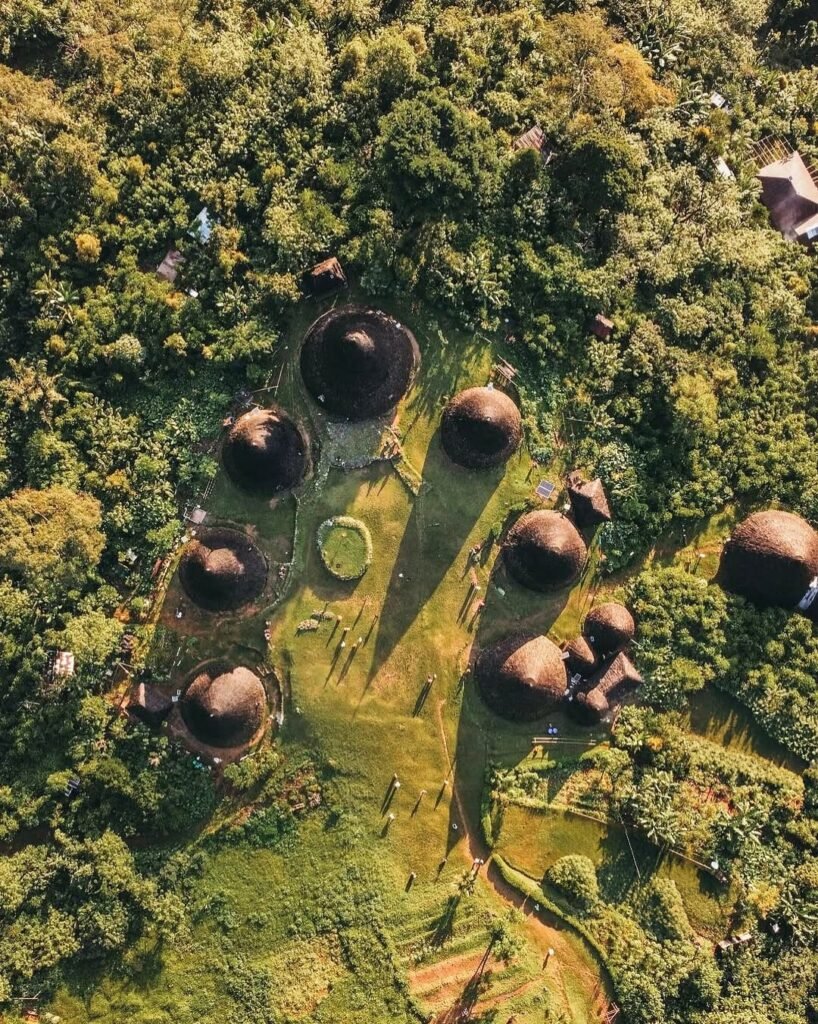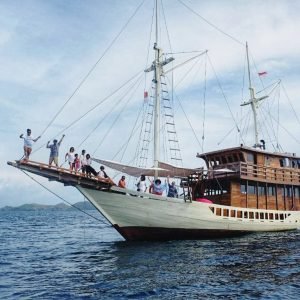Introduction to Wae Rebo Village
Wae Rebo Village Tour from Labuan Bajo or Ruteng-Nestled in the mountains of Flores, Indonesia, Wae Rebo Village is a captivating destination that offers visitors a unique glimpse into the rich cultural tapestry of the region. This traditional village is renowned for its distinctive circular houses, known as Mbaru Niang, which are architecturally representative of the indigenous Manggarai people’s heritage. Surrounded by lush green valleys and dramatic mountain landscapes, Wae Rebo is not only an architectural marvel but also a site of profound cultural significance.
Located approximately 1,200 meters above sea level, Wae Rebo can be accessed from either Labuan Bajo or Ruteng, making it a compelling stop for travelers exploring Flores. The journey to the village often involves a scenic trek that immerses visitors in the natural beauty of the surroundings. Towering peaks, terraced rice fields, and vibrant flora create a picturesque backdrop, elevating the anticipation of reaching this secluded enclave.
Wae Rebo Village is not just a picturesque destination; it is also a living testament to the traditions and customs of the Manggarai people. Visitors have the opportunity to engage with local communities, learning about their way of life, traditional rituals, and the importance of preserving their culture in the face of modernity. The villagers often welcome guests with open arms and share their ancestral stories, enriching the cultural experience.
In addition to the cultural immersion, the natural surroundings of Wae Rebo enhance its allure. Hiking enthusiasts can explore numerous trails that reveal breathtaking vistas, while those seeking tranquility can enjoy the serene atmosphere that envelops the village. For travelers prioritizing authentic experiences, Wae Rebo Village stands out as a must-visit locale in Flores, offering a chance to connect with the natural world and local heritage in a meaningful way.
Getting to Wae Rebo Village from Labuan Bajo
The journey from Labuan Bajo to Wae Rebo Village is a fascinating adventure that encapsulates the beautiful landscapes and cultural richness of Indonesia. Travelers have several transportation options to choose from, with the most common being rental cars or guided tours. For those who prefer a self-drive option, it is crucial to rent a vehicle suitable for the terrain, as the roads can vary significantly in quality. Renting a 4WD vehicle is generally recommended for a more comfortable and safer journey.
The distance between Labuan Bajo and Wae Rebo Village is approximately 150 kilometers, and the travel time typically ranges from 6 to 8 hours, depending largely on road conditions and your vehicle’s performance. As you traverse through the picturesque hills and valleys, expect to confront steep inclines and winding roads, so be prepared for slow-paced travel. If you opt for a guided tour, many operators provide sturdy transport and knowledgeable drivers, allowing travelers to enjoy the scenery without the stress of navigation.
It is also advisable to check weather conditions before setting off, as heavy rains can lead to mudslides and make certain areas inaccessible. Furthermore, it’s essential to consider that some sections of the road may be under maintenance. While planning your trip, it is wise to allocate extra time to account for any unexpected delays. Keeping an open mind and a flexible schedule will enhance your overall experience. In addition, speaking with locals can offer valuable insight into the best travel routes, as they are often familiar with the latest conditions and can guide you safely to Wae Rebo Village.
In conclusion, whether choosing to drive yourself or join a guided tour, the journey from Labuan Bajo to Wae Rebo Village promises to be a rewarding experience filled with breathtaking views and local culture that will make your trip unforgettable.
Getting to Wae Rebo Village from Ruteng
Traveling to Wae Rebo Village from Ruteng provides a wonderful opportunity to immerse oneself in the breathtaking landscapes of Flores, Indonesia. The journey commences from Ruteng, a town known for its cool climate and rich cultural heritage. The most common route to the village is by road, with various transport options available to suit different preferences and budgets.
For those prioritizing convenience, hiring a private car or arranging a taxi can be an excellent choice. This allows travelers to set their own pace and stop along the way to enjoy the stunning vistas. The ride takes approximately two to three hours, but the scenic beauty of rice fields, lush hills, and traditional villages makes the journey significantly rewarding. Alternatively, public transportation is an option, with minibusses (often called ‘angkot’) that frequently travel between Ruteng and the starting point of the hike to Wae Rebo. These minibusses are cost-effective, though they can be crowded and may require a bit of patience.
Regardless of the transport mode chosen, travelers should prepare for a trek once they reach the nearest point to Wae Rebo Village. The final leg of the journey involves a hike ranging from 2 to 3 hours, depending on individual fitness levels and pace. This hike leads through beautiful landscapes, often accompanied by the sounds of nature, creating an enchanting atmosphere. Therefore, it is advisable to wear comfortable shoes and carry sufficient water. Along this scenic trek, travelers can appreciate the flora and fauna unique to the region, making this segment of the trip particularly memorable. Overall, the travel to Wae Rebo Village from Ruteng is not just a transition but a vital part of the adventures awaiting visitors to this mystical village.
What to Expect During Your Visit to Wae Rebo Village
Visiting Wae Rebo Village offers a unique opportunity to immerse oneself in a rich cultural tapestry woven from centuries of tradition. Nestled amid the lush hills of Flores, this remote village showcases stunning traditional houses, known locally as “Mbaru Niang,” which are characteristic of the Manggarai culture. These conical structures, constructed from bamboo and thatch, rise majestically above the landscape, providing a glimpse into the architectural heritage of the region.
Upon arrival, visitors are welcomed with genuine hospitality reflective of Wae Rebo’s local customs. The inhabitants take pride in sharing their way of life, which emphasizes the importance of community and respect for nature. A tour through the village reveals daily activities such as farming, weaving, and communal gatherings, each demonstrating the deep connections that the villagers maintain with their land and each other. Guests may have the opportunity to participate in traditional rituals or engage in activities like weaving, giving them insight into the skills and craftsmanship that have been passed down through generations.
The atmosphere of Wae Rebo is intricately linked to its stunning natural surroundings and the simplicity of life it offers. Visitors quickly find themselves disconnected from modern distractions, allowing for moments of reflection and appreciation for the serene environment. The cool mountain air and panoramic views create a setting conducive to relaxation and introspection, making it an ideal escape for those seeking solace. The village serves as a reminder of the importance of preserving traditional customs and appreciating the beauty of an unhurried life, encapsulating a spirit that resonates long after the visit concludes.
Activities to Enjoy in Wae Rebo Village
Wae Rebo Village, nestled amidst the stunning mountains of Flores, offers a unique blend of natural beauty and rich cultural heritage, providing visitors with numerous engaging activities. One of the most popular pursuits in Wae Rebo is trekking. Adventurous travelers can embark on scenic hikes through lush landscapes, characterized by terraced rice fields and dense forests. The trek to Wae Rebo itself is an unforgettable experience, typically taking around 3 to 4 hours. Along the way, trekkers can enjoy panoramic views, diverse flora and fauna, and the fresh mountain air, making it an ideal outdoor activity for nature enthusiasts.
Photography is another highlight for many visitors. The iconic Mbaru Niang houses, with their traditional cone-shaped roofs, create a picturesque setting against the backdrop of the surrounding hills. Sunrise and sunset provide particularly stunning lighting for capturing the village’s enchanting beauty. Additionally, the vibrant local culture offers endless opportunities for candid shots, showcasing daily life and the warmth of the villagers.
Immersive cultural experiences are also a significant part of a visit to Wae Rebo. Tourists have the opportunity to participate in various cultural rituals, providing insight into the customs and traditions of the Manggarai people. This might include traditional dances, local culinary experiences, or communal gatherings, where visitors can engage with the locals and learn about their way of life. Many villagers share stories of their ancestry, connecting visitors to the history that has shaped this tranquil community.
Overall, Wae Rebo Village stands out as a destination where outdoor activities, photography, and cultural immersion intertwine, creating unforgettable memories for every traveler. Each experience in this enchanting village deepens one’s understanding of the local culture while embracing the natural beauty that surrounds it.
Culinary Delights of Wae Rebo Village
Wae Rebo Village, nestled in the highlands of Flores, Indonesia, offers visitors not only stunning views and rich culture but also a unique culinary experience that reflects its traditional way of life. The food in Wae Rebo is deeply intertwined with the identity of the community, showcasing the agricultural practices and the cultural significance of local ingredients.
The primary staple of the Wae Rebo diet is rice, often cultivated in terraced fields that are impressive to observe. Beyond rice, the traditional cuisine features a variety of local vegetables and fruits such as sweet potatoes, taro, and papaya. Upon visiting, one can expect to indulge in signature dishes like “nasi liwet,” a fragrant rice dish cooked with coconut milk and herbs. This dish is typically accompanied by “ikan bakar” (grilled fish), which is often caught fresh from nearby streams.
Cooking methods in Wae Rebo often include using a traditional bamboo steamer and slow-cooking over an open flame, imparting a distinctive smoky flavor to the dishes. The villagers take pride in their gastronomic heritage, which includes recipes handed down through generations. Community gatherings often revolve around food preparation, where locals come together to cook, share stories, and strengthen communal bonds.
Another must-try is “sate,” skewered meat that is marinated and grilled. Variations exist depending on the type of meat sourced locally, and the accompanying sauce, made from a blend of spices and possibly local fruits, adds a tangy twist. Visitors may also enjoy traditional snacks such as “kue cubir,” a sweet treat made from rice flour, often served during festivals.
Overall, the culinary delights of Wae Rebo Village offer a glimpse into the heart of its culture. Through its traditional foods and cooking methods, visitors can truly appreciate the significance of cuisine as part of the community’s heritage and identity.
Tips for a Successful Wae Rebo Village Tour
Embarking on a tour of Wae Rebo Village is an enchanting experience that requires careful planning to ensure an unforgettable visit. Timing your trip is crucial. The best months to explore this remote village are typically from April to November, as these months offer the driest weather conditions, allowing for pleasant trekking experiences. Conversely, December through March can bring heavy rainfall, potentially hindering travel and limiting accessibility to the stunning views that Wae Rebo is known for. Therefore, aligning your visit with the ideal weather conditions will greatly enhance your journey.
Packing appropriately for the trek to Wae Rebo is essential. Comfortable walking shoes are a must, as the path can be steep and uneven. Lightweight, breathable clothing suited for the tropical climate will help keep you cool during the hike. Additionally, it is advisable to bring a waterproof jacket and a small daypack to store your essentials, including water, snacks, and a first aid kit. Don’t forget your camera to capture the village’s remarkable traditional houses, known as Rumah Adat, and the breathtaking landscapes surrounding the area.
When visiting Wae Rebo, it is important to respect the local culture and customs. Engage with the residents in a friendly manner, and take the time to learn about their way of life. Always ask for permission before taking photographs of people or their homes. Participating in village activities or sharing stories with the locals can create a meaningful connection and enrich your experience. As a visitor, being respectful and mindful of local traditions will not only enhance your journey but also foster positive interactions with this fascinating community.
Sustainable Tourism Practices in Wae Rebo Village
Sustainable tourism plays a crucial role in preserving the unique cultural heritage and pristine natural environment of Wae Rebo Village. This enchanting village, located in the mountainous region of Flores, Indonesia, is not only famous for its iconic traditional houses but also for its commitment to sustainable practices that benefit both the local community and visitors. By promoting eco-friendly activities, Wae Rebo aims to balance the influx of tourists with the need to protect its cultural and environmental resources.
Initiatives such as community-based tourism have been implemented to ensure that the benefits of tourism are shared by the residents of Wae Rebo. Local guides, trained in sustainable practices, provide visitors with authentic experiences while educating them on the importance of preserving the rich heritage of the village. These guides emphasize responsible tourism by encouraging guests to respect local customs and traditions, minimize waste, and engage in conservation efforts.
Furthermore, the community has taken active steps to protect its natural surroundings through reforestation projects and the promotion of organic farming. Visitors are often invited to participate in these projects, thus contributing positively to the environment while gaining insights into the local way of life. This hands-on approach not only enriches the traveler’s experience but also fosters a deeper connection between tourists and the local community.
Wae Rebo Village’s commitment to sustainable tourism is essential for ensuring that its cultural and natural assets are preserved for future generations. By prioritizing sustainable practices, the village is setting an example for other tourist destinations, demonstrating that it is possible to welcome tourists while maintaining respect for the environment and indigenous culture. Ultimately, the visitation experience in Wae Rebo contributes to a more sustainable future, benefiting both the locals and the travelers who seek to explore this remarkable destination.
Conclusion: Why Wae Rebo Village Should Be on Your Travel List
Wae Rebo Village encapsulates a unique blend of cultural richness, stunning landscapes, and an immersive experience that highlights the traditional way of life in Indonesia. As travelers seek destinations that offer not just sightseeing, but a deeper connection to local culture, Wae Rebo stands out as an exemplary choice. Nestled in the mountains, this village offers picturesque views and an atmosphere that feels untouched by the modern world, making it a must-visit for those wanting to venture beyond bustling tourist spots.
The journey to Wae Rebo is not merely a trip; it transforms into an adventure that begins with the scenic trek from Labuan Bajo or Ruteng. Visitors are rewarded with breathtaking vistas, lush hills, and opportunities to encounter local flora and fauna. The trek itself is a significant aspect of the Wae Rebo experience, allowing travelers to appreciate the natural beauty that surrounds this remarkable village.
Moreover, the warmth and hospitality of the Wae Rebo community enhance the appeal of this destination. Learning about the local traditions, participating in village activities, and enjoying traditional meals allow travelers to engage with the local culture in a meaningful way. These interactions instill a sense of appreciation for the indigenous ways of living, amidst breathtaking backdrops that serve as a reminder of nature’s splendor.
In light of these experiences, Wae Rebo Village not only deserves a place on your travel itinerary but also promises to create lasting memories. For those exploring Indonesia, the enchanting allure of Wae Rebo Village proves to be an essential and unforgettable addition to your travel list. Its unique charm, scenic beauty, and rich culture leave an indelible mark on those fortunate enough to visit.


